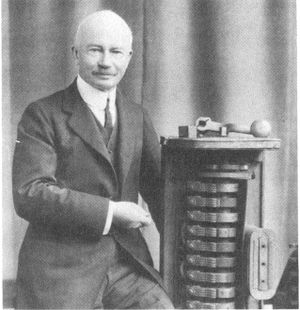William B. Potter
- Birthdate
- 1863/02/19
- Birthplace
- Thomaston, CT, USA
- Death date
- 1934/01/15
- Associated organizations
- General Electric (GE)
Biography
William Bancroft Potter was born on February 19th, 1863 at Thomaston, Connecticut, to Horace and Charlotte Potter, a farmer. He entered the engineering field at age 15 by means of a summer job at the Seth Thomas clock factory, and declined to attend MIT in 1883 in favor of apprenticing at the Sawtell and Judd marine engineering firm in Hartford, where he worked for four years. His work here mostly involved repairing stationary and marine engines, but while repairing the engines of the Hartford electric lighting station, Potter's desired to add knowledge of electrical engineering to his mechanical skillset. Potter began to study the dynamo, and became employed at the Thomson-Houston Electric Company's Lynn, MA works.
On Potter's first assignment in 1887, installing a dynamo at the Greensboro, North Carolina plant, an angry customer brandished a revolver and demanded to see the engineer, threatening to shoot the machine. Potter allegedly replied "Shoot as much as you like, but you will surely be killed by the lightning that will come out of the dynamo". After Greensboro, Potter was involved in overhauling the electric light station at Raleigh, NC, and was acting superintendent for 18 months. During this period, Potter saw his first trolley car in Washington, left Raleigh in 1889 and returned to Lynn to pursue work in electric railway construction.
In the spring of 1890, he worked on the West End Street Railway power station at Cambridge, MA, the Utica Railway, the Saratoga street railway, and the Alamo electric railway of San Antonio, TX. After these installations, Potter returned to Lynn, MA, and entered the shops as an assistant to J.B. Cahoon in the railway engineering department, his first work was in connection with the development of the S.R.G. motor, the first single reduction motor of the Thomson-Houston company. Potter was later assigned the problem of developing a successful series-parallel controller for electric cars, and due to his successes in this area, was put in charge of controller and switchboard work. He transferred to Schenectady in 1894, and in 1895, he succeeded W.H. Knight as the chief engineer of the General Electric Company's Railway department, a position he held until his retirement in 1930.
Potter was a member of the American Society of Civil Engineers, the American Society of Mechanical Engineers, and the American Institute of Electrical Engineers. Potter died on January 15th, 1934.
